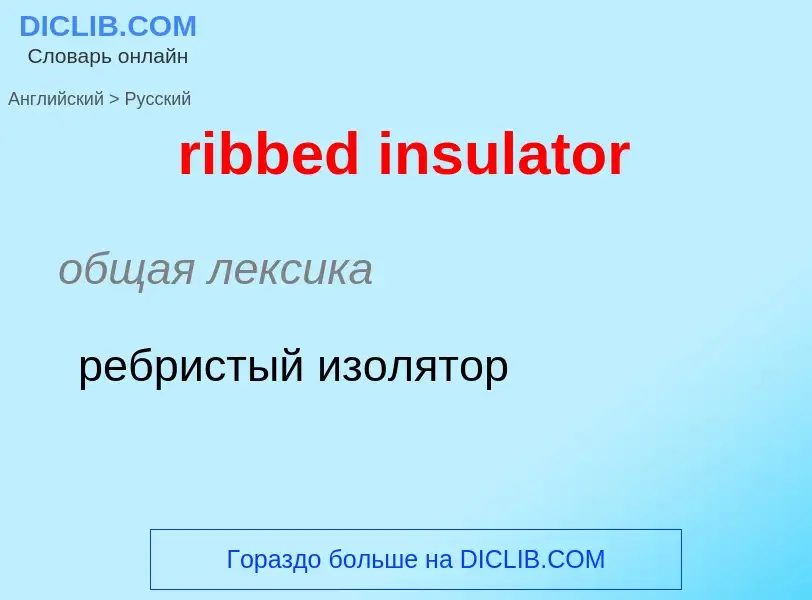Translation and analysis of words by ChatGPT artificial intelligence
On this page you can get a detailed analysis of a word or phrase, produced by the best artificial intelligence technology to date:
- how the word is used
- frequency of use
- it is used more often in oral or written speech
- word translation options
- usage examples (several phrases with translation)
- etymology
ribbed insulator - translation to russian
общая лексика
ребристый изолятор
['kri:pidʒ]
Смотрите также
существительное
общая лексика
очень медленное движение
скользящий разряд
техника
ползучесть
Definition
Wikipedia

A Rogen moraine (also called ribbed moraine) is a subglacially (i.e. under a glacier or ice sheet) formed type of moraine landform, that mainly occurs in Fennoscandia, Scotland, Ireland and Canada. It is one of the three main types of hummocky moraines. They cover large areas that have been covered by ice, and occur mostly in what is believed to have been the central areas of the ice sheets. Rogen moraines are named after Lake Rogen in Härjedalen, Sweden, the landform's type locality. Rogen Nature Reserve serves to protect the unusual area.
The landform occurs in groups that are often closely and regularly spaced. They consist of glacial drift, with till being the most common constituent. The individual moraines are large, wavy ridges orientated transverse to ice flow. Drumlins are often found in close proximity of Rogen moraines, and are often interpreted to be formed at the same time as the Rogen moraines. Although Rogen moraines can span a large range of sizes, the most common distribution seems to be 10–30 metres high, 150–300 metres wide and 300–1,200 metres long.
The exact mechanics of Rogen moraine formation are not known, but since the 1970s, several theories on the formation have been proposed:
- Megaripples eroded in the basal ice fill during subglacial outburst floods.
- Already existing landforms, such as drumlins and flutes or marginal moraines are reshaped due to a ≈90° change in the direction of the ice flow.
- Debris-rich basal ice or pre-existing sediments are sheared and stacked, or folded during compressive ice flow.
- Shearing of sediment under a glacier causes growth of waves with spacing characteristic of Rogen moraine (300 m to 1000 m).
- Sediment sheets become fractured and extended during a transition of the overlying glacier from being cold based ice to warm based.
However, it has been suggested that, due to the diversity of morphological characteristics displayed by Rogen moraine, different processes might be able to create the landform. This means that all of the processes mentioned above might be correct. The different theories that proposed a formation near or at the glacial margin have largely been abandoned. Some of these theories proposed that Rogen moraines had an origin as a series of end moraines, that they formed in association with calving ice termini in glacial lakes, or that Rogen moraines formed in dead-ice, where supraglacial material fell down into crevasses in the ice.





![glazing]] (1977) glazing]] (1977)](https://commons.wikimedia.org/wiki/Special:FilePath/Fotothek df n-15 0000283 Facharbeiter für Sintererzeugnisse.jpg?width=200)
![PVC-sheathed [[mineral-insulated copper-clad cable]] with two conducting cores PVC-sheathed [[mineral-insulated copper-clad cable]] with two conducting cores](https://commons.wikimedia.org/wiki/Special:FilePath/MICCCable.jpg?width=200)
![open-wire]] transmission for telephone communication, manufactured for AT&T in the period from c. 1890 to WW-I; It is secured to its support structure with a screw-like metal or wood pin matching the threading in the hollow internal space. The transmission wire is tied into the groove around the insulator just below the dome. open-wire]] transmission for telephone communication, manufactured for AT&T in the period from c. 1890 to WW-I; It is secured to its support structure with a screw-like metal or wood pin matching the threading in the hollow internal space. The transmission wire is tied into the groove around the insulator just below the dome.](https://commons.wikimedia.org/wiki/Special:FilePath/Open-wire glass insulator for telephone transmission lines 20221225 kbrose.jpg?width=200)
![Open-wire telegraph pole with porcelain insulators in [[Quidenham]], [[Norfolk]], [[United Kingdom]] Open-wire telegraph pole with porcelain insulators in [[Quidenham]], [[Norfolk]], [[United Kingdom]]](https://commons.wikimedia.org/wiki/Special:FilePath/Pole Route.jpg?width=200)


![Power lines supported by ceramic pin-type insulators in [[California]], USA Power lines supported by ceramic pin-type insulators in [[California]], USA](https://commons.wikimedia.org/wiki/Special:FilePath/Power line with ceramic insulators.jpg?width=200)



![Insulator [[handle]] on [[electric fence]] for [[cattle]] Insulator [[handle]] on [[electric fence]] for [[cattle]]](https://commons.wikimedia.org/wiki/Special:FilePath/Isolator - Öja mosse - Ystad-2021.jpg?width=200)
